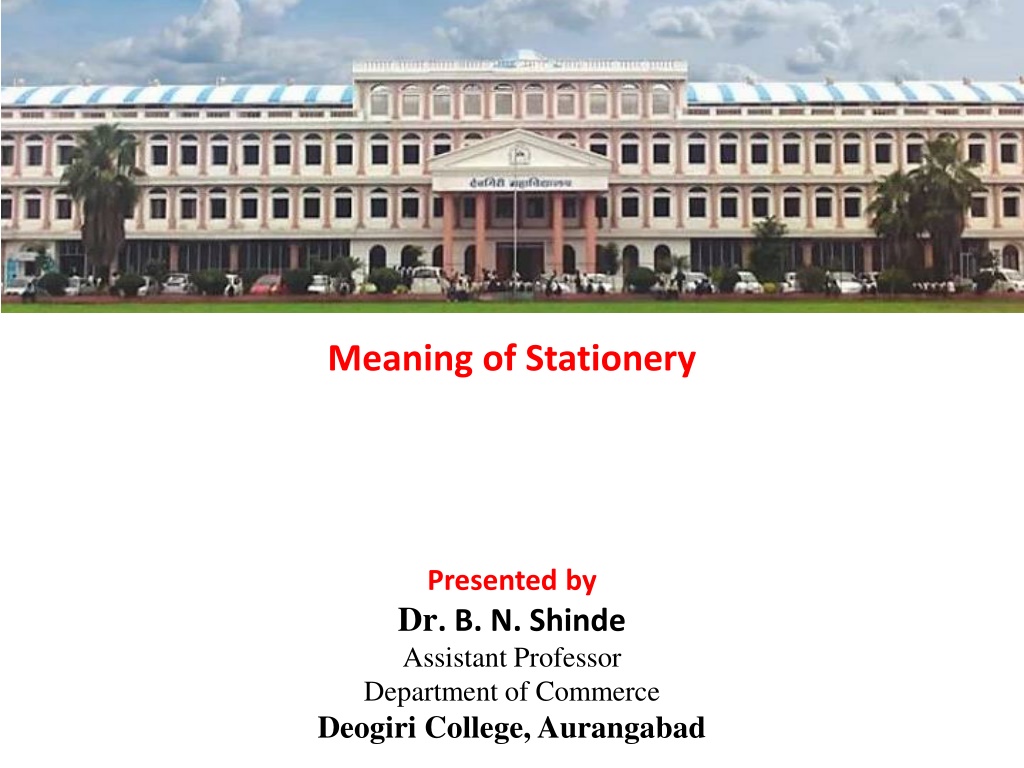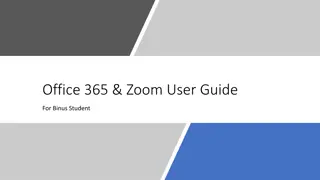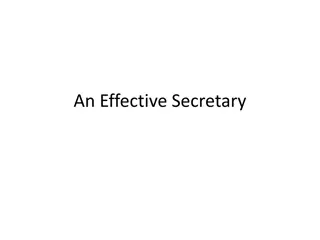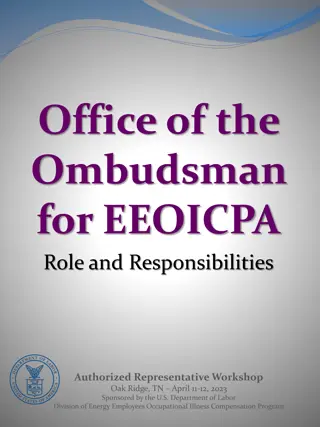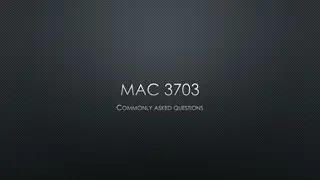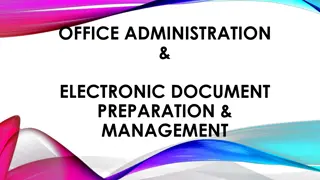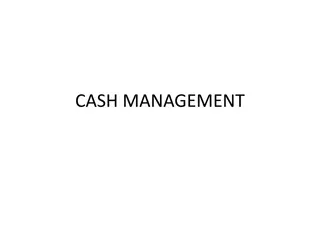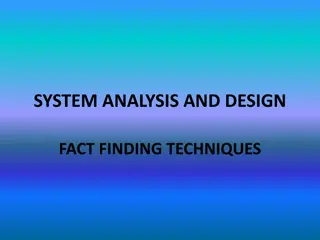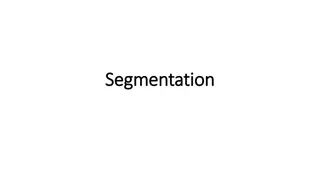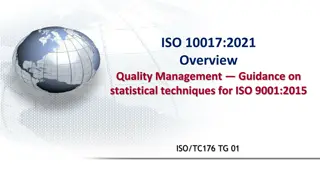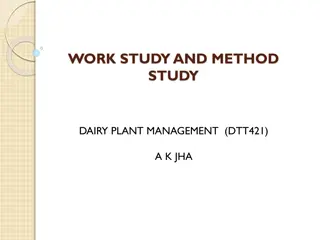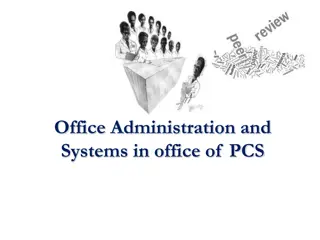Understanding Office Stationery and Effective Management Techniques
Stationery encompasses commercially produced writing materials essential for office tasks, such as paper, envelopes, and instruments. Office stationery can be categorized as consumable, durable, and adhesive items. Effective management of office stationery is crucial for reducing overall expenditure, with tips like minimizing paper usage and implementing strict rules for resource handling.
- Office stationery
- Management techniques
- Consumable items
- Cost-cutting
- Effective resource utilization
Download Presentation

Please find below an Image/Link to download the presentation.
The content on the website is provided AS IS for your information and personal use only. It may not be sold, licensed, or shared on other websites without obtaining consent from the author. Download presentation by click this link. If you encounter any issues during the download, it is possible that the publisher has removed the file from their server.
E N D
Presentation Transcript
Meaning of Stationery Presented by Dr. B. N. Shinde Assistant Professor Department of Commerce Deogiri College, Aurangabad
Meaning of Stationery Stationery is a mass noun referring to commercially manufactured writing materials, including cut paper, envelopes, instruments and other Stationery includes materials to be written on by hand (e.g., letter paper) or by equipment For example: computer, printers. writing office supplies.
Continue A stationery, precisely the office stationeries, is a group of commodity which is used to, or which is needed to, do the office job for completing the office job, as per the requirement and specification. Every office has to maintain certain records, both in the form of filings, and in the way and method of information technology. These records which has to be filed for a longer duration of time, has to be typed and preserved for a longer duration of time. This gives birth to, or thus arises the need of office stationeries.
Continue Office stationery can classified into three broad categories: A) Consumable: Consumables are those items which are used by the office very quickly, in a very short period of time and which cannot be re-used. For example- Paper, stencils (Produces image and pattern by applying pigment), ink, eraser, refill, Chalk, pencil etc. B)Durable : Durables are those items which find a constant use and which remain in its shape, form and size for a very longer period of time. These items can be re-used or these are often used. For examples: Stapler, Punching machine, Clips, Paper- weights.
Continue C) Adhesive: Adhesives are those items which are used to stick, paste or fix something. These items are usually chemicals or made of chemicals used on a particular surface for affixing, or fixing or pasting a commodity. For example: Steps, Fixersetz etc.
Handling office stationery effectively If you are really concerned about cutting down the office expenditure but do not want to pinch your employees' pockets, the best suited way would be to handle the resources in the best possible way. The most important department that costs you quite a bit is the office stationery. Here is where one needs to have a check so as to cut down on the total expenditure figures.
Continue The following tips would help in this regard - 1. Always encourage your employees to reduce the paper work. Some people have the weird habit of printing out the stuff just to check them out. Ask them to do it directly from the computers. 2. Lay strict rules of not taking home the office stuff (office materials) even if it is not for personal use. By doing so, it is possible to control the misuse of the office stationery. 3. Recycle stuff - Always look in for notepads, pens, files and other stuff that were disposed off even before half of its utility was done. By doing so, you can cut the costs incurred by buying new ones for it.
Continue 4. Have a close check on the stationery inventory and always keep track of all the inward and outward movements. This will in turn reduce the unwanted usage of stationery in issues of very less priority. 5. Always order stationery in bulk. This will help out in saving a considerable amount of money as well. On the downside, you might end up spending more than required up-front, yet, it's a saving in long-term.
Purchase procedure: Principles of Purchase of stationery Generally, the office manager is responsible to buy the stationery. He has to consider utility, price, quality, quantity, and storage facility before placing an order. The principles of purchase of office stationery 1. Purchasing at the right time. 2. Purchasing of the right quantity. 3. Purchasing at the right place. 4. Purchasing of the right quality. 5. Purchasing at the right price. are listed below:
Steps in Purchase procedure of stationery 1. The user departments or sections have given purchase requisitions. 2. Sometimes, the storekeeper may inform the purchase officer to buy the stationery items, which have reached the minimum level. 3. The purchase officer may place the order by considering the rate of use of stationery and the balance of stock in hand. 4. Re-order quantity is taken into account for placing an order. 5. The purchase officer has to consider offer, discount, price, after sales service, quality, design and the like.
Continue.. 6. The purchase officer makes enquiries from the suppliers about the terms and conditions of supply and asks for price lists, quotations etc after deciding the type of stationary required. 7. The purchase officer has to prepare the comparative statement based on price lists, quotations and samples sent by the suppliers. 8. The purchase officer can commence negotiations with suppliers based on lowest price quoted by the supplier. 9. The supplier has decided the terms and conditions for supply of stationery items and purchasing officer, then an order has been placed with the selected supplier in a prescribed form.
Continue.. 10. The purchasing order contains the details like quantity, quality, rate, time of delivery, terms of payment etc. 11. The purchasing officer or the office manager may sign the order. 12. The purchase officer also takes the follow up action if there is any delay in the delivery of stationery items. 13. The purchase officer has to check up the stationery items whether they are supplied according to order or not. 14. After receiving the stationery items, entries are made in the stationery stock register under appropriate heads. 15. Then, the purchase officer has to inform the department, which requisitioned the stationery regarding receipt of the same from the supplier.
STANDARDIZATION OF OFFICE SUPPLIES Standardization of office supplies is an important job in any big office. Here, it means that stationery items should be identical in terms of quality, size and description. Standards can be laid down for almost every kind of stationery. standardization involves the laying down of the exact size, quality, dimensions and other specification of each item of supplies. The process of
Advantages of Standardization Standardization has the following advantages: i. It helps the office buyer to know the requirements of his/her office exactly and precisely ii. It ensures uniformity in the specifications of the items required by the various departments. iii. It encourages simplicity by eliminating unusual and complicated articles. iv. It discourages the purchases of substandard supplies which lead to economies in usage and storage. v. It makes bulk purchases possible, and the economy that flows from bulk purchases.
CONTROL OVER OFFICE STATIONARY AND SUPPLIES One can-not think of running an office without stationeries and office supplies. Office stationeries are those expendable items which are necessary for and consumed in the daily operations but do not generally enter into finished product. Office stationeries and supplies comprise of office forms, letter-heads pads, rough-work pads, envelopes, pencils, pens, erasers, pins, tags, files and folders.
CONTROL OVER OFFICE STATIONARY AND SUPPLIES Office stationeries occupy a key position in the office activity because proper and efficient use of stationeries and supplies brings the following advantages to the firm. (a) It provides better service at lowest cost. (b) It occupies 30-40% of the non-salary cost and therefore is viewed seriously by the management. (c) It facilitates smooth functioning of office work. The need for proper control of stationeries arise because it will cause the following difficulties. to the firm.
Continue Control over stationery in stores may be exercised in the following ways: 1.Fixation of Levels: The simplest method of ensuring continuous supply of all stationery items is to determine the minimum, maximum and reorder levels of the stationary items. These levels may be fixed on the basis of past experience of the rate of consumption, the time taken for placing an order and arrival of fresh supplies etc.
Continue 2. Two-Bin System: The two bin system may be employed to keep in Bin-B some quantity of stock to be used to avoid the stock-out position. When the supplies of Bin-A have been exhausted, an order for the fresh supplies may be placed for its replenishment before the reserved stock in Bin-B is completely used up. 3. Stock-Taking: There are three methods of stock taking, they are: perpetual, continuous and periodic. Under perpetual stock-taking, the continuing of the quantities in stock is made at the time of receipts and issues. The system may be adopted for costly items and for those which are stored in large quantities so that pilferage may be avoided. Under the continuous stock-taking system, a fixed number of items are counted and checked daily so that the whole stock is checked in a fixed period of time. Under the periodic stock-taking system, all the items in stock are checked and counted only at the end of the financial year. Any or a combination of the three methods may be adopted in accordance with the firms requirement.
